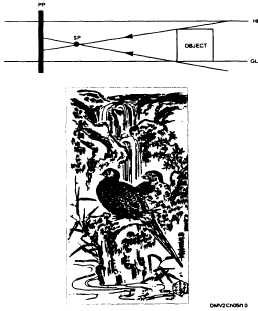Reverse Perspective
Introduction
Asian and eastern cultures approach perspective from an opposite philosophy.
The traditional oriental artist believed that parallel lines converged as the
lines approached the spectator. This belief involves the observer as an active
participant in the image rather than a passive bystander. This philosophy or
technique is known as reverse perspective. For further study in reverse
perspective, study works before 1729, particularly those paintings executed
by Japanese artist Kiyonobu, founder of the Torii school.
Reverse
perspective
Reverse perspective is when parallel horizontal lines converge as they
approach the observer. This technique requires the location of the picture
plane behind the station point creating the illusion of enclosing or limited
space that actively involves the observer in the image area. The observer
sees the image as large, flat (in perspective), and detailed (without the affects
of aerial perspective). The spatial panorama presented to the observer is
rarely noticeably enclosed by an implied picture plane.
Figure 5-10 illustrates the location of the picture plane and a resultant
perspective.
Figure 5-10.—Reverse perspective.
5-11


